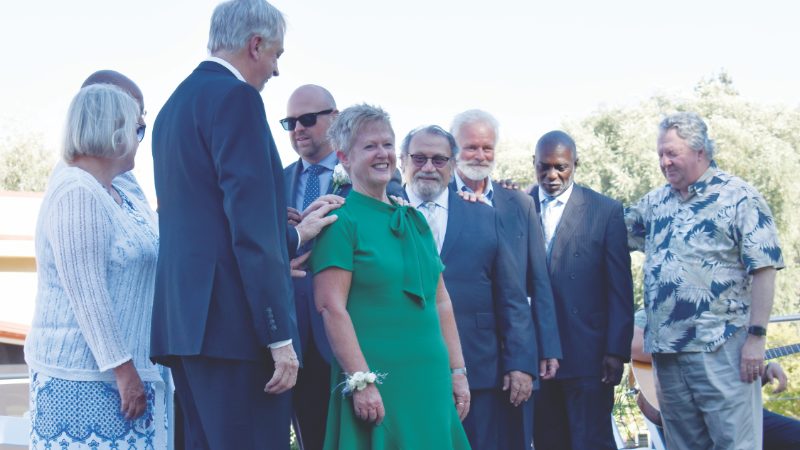After I concluded a weekend series of sermons at a local church, a couple approached me, requesting a private conversation. I assumed they either had marital issues or wanted to delve deeper into my presentations. I was entirely wrong—they wanted to talk about: me.
Their concern revolved around my use of humor during the sermons. This wasn’t the first time someone had raised this issue. Despite my attempts to explain my perspective, they remained unconvinced.
Before I proceed, let me clarify my approach to humor in preaching: a) I take humor seriously; b) I plan it carefully, ensuring it’s never offensive, belittling, or inappropriate; c) I love to smile and laugh, and I genuinely want others to share in that experience.
In the last two instances where my humor was questioned, the feedback revealed two significant misunderstandings that are common, particularly in ethnic churches in North America: theological confusion and a blurring of tradition and culture.
Some people confuse our modern church buildings with the biblical temple. While distinct in function, both spaces are made sacred by the presence of God. Yet, when Christ told His disciples that He would dwell within them through the Holy Spirit, He was revealing that the true temple is now within us—in our hearts. This means God resides in us, not just in physical structures. If we truly are seeking to honor God, we must rethink our relationship to one another. Reverencing a place where God is present doesn’t mean we must be somber or, worse, dour. There is room for joy, even laughter, in the presence of the Almighty.
Another misconception stems from traditions we’ve inherited from other religious practices, especially Catholicism. Gothic cathedrals, for example, were designed to evoke a sense of smallness in the commoner. Hierarchies between the laity and clergy were underscored by the vastness and silence of the buildings, instilling reverence through fear and unworthiness.
The Seventh-day Adventist Church views people as equals, recognizing that our buildings, while special, are not sacred like the ancient temple. Instead, we gather in these places to worship God, love each other, and serve our communities.
Joy in worship
Life is already stressful and complex. Churches should be sanctuaries of joy, where smiles and laughter are not only welcomed but celebrated.
Recently, I came across a book that dives deeper into the importance of joy from both scientific and theological perspectives. The human brain, as you know, operates through two hemispheres. The left brain handles logic, knowledge, and reasoning, while the right brain processes emotions, creativity, and relationships.
For a long time, we’ve assumed that building our logical knowledge of God through doctrine and theology would lead to personal transformation. However, recent research shows that true faith development begins in the right brain, with relationships and emotions, and then permeates into the logical, left-brain thinking.
In other words, science is now confirming what Scripture has long taught—spiritual growth is deeply tied to relationships, community, and joy. We thrive when we experience love, belonging, and, yes, joy.
Joy and laughter significantly impact our spiritual growth and community life. Joy is a foundational element of the Christian experience, intricately linked to our relationship with God and with one another.
In the book The Other Half of Church1, the authors define joy as a deep sense of gladness that arises from being in the presence of someone who is genuinely happy to be with you. This joy is more than a fleeting emotion; it is a relational experience that reshapes both our minds and hearts.
Joy in God’s presence
The Bible is replete with references to joy in the presence of God. Psalm 16:11 says, “You make known to me the path of life; you will fill me with joy in your presence, with eternal pleasures at your right hand.”2 Similarly, Psalm 21:6 celebrates, “You have granted him unending blessings and made him glad with the joy of your presence.”
As image-bearers of God, the joy we experience within our church communities reflects the joy found in His presence. It’s a profound concept—one that we, as Christians, may not always fully appreciate.
The authors of the book mentioned above delve into the neuroscience of joy, revealing that joy activates the brain's relational circuits. When these circuits are engaged, we connect better with others, experience empathy, and grow spiritually. Joy, they argue, is the fuel for spiritual and emotional maturity.
Nehemiah 8:10 underscores this, stating, “The joy of the Lord is your strength.” Joy is not just an emotional experience; it is a source of strength for both individuals and communities. Rooted in God, joy empowers us to thrive spiritually and relationally.
The role of joy in transformation
Our Jewish brothers and sisters have long understood the transformative power of joy, as evidenced by the celebration of Purim, a festival dedicated to happiness and rejoicing. In the Christian context, joy is central to our relationship with Jesus. It is the very face of Christ that transforms us.
For too long, we’ve focused on left-brain activities—acquiring knowledge of doctrines—while neglecting the right-brain activity of cultivating joy. But Jesus wants His joy to be within us: “I have told you this so that my joy may be in you and that your joy may be complete” (John 15:11).
Communities rooted in joy are environments where healing, growth, and deep relational connections flourish, reflecting the true nature of Christ to the world.
Joy is contagious. A church community that prioritizes joy will build resilient members who can endure challenges and foster environments of growth and healing. Joy-filled relationships reflect the love of Christ and invite others to follow Him.
As Paul writes in 1 Thessalonians 2:19-20, “For what is our hope, our joy, or the crown in which we will glory in the presence of our Lord Jesus when he comes? Is it not you? Indeed, you are our glory and joy.” Early Christians understood that joy was deeply tied to their relationships with one another.
Joy can be cultivated
Practice gratitude. Like the Israelites in the desert, we often forget God’s provisions and miracles, even when they are right in front of us. Remind yourself of God’s greatness and express your thankfulness to Him and others.
Build authentic relationships. Joy is not a superficial feeling but a transformative force rooted in our connection to Jesus and one another. Prioritize deep, joy-filled relationships that foster spiritual growth.
Adopt the attitude of a servant. Discover the joy of serving those around you. Communities rooted in joy are environments where healing, growth, and deep relational connections flourish, reflecting the true nature of Christ to the world.
Ultimately, joy was the driving force behind Christ’s ultimate sacrifice: “For the joy set before him he endured the cross, scorning its shame, and sat down at the right hand of the throne of God” (Hebrews 12:2). Jesus was motivated by the joy of fulfilling God’s will and restoring humanity to a relationship with Him.

Joy is transformative. It leads to spiritual growth, strengthens communities, and is conducive toward fostering better relationships. Embrace the joy of God’s presence in your life today and let it shine through you as you journey through life.
Smile, dear friend.
_____________________________
Carlos A. Camacho is president of the Nevada-Utah Conference of Seventh-day Adventists.
1 Jim Wilder and Michel Hendricks, The Other Half of Church: Christian Community, Brain Science, and Overcoming Spiritual Stagnation (Chicago: Moody Publishers, 2020).
2 Unless otherwise indicated, all Scripture quotations are from the New International Version.
El poder transformador de la alegría
Por Carlos A. Camacho
Después de concluir una serie de sermones un fin de semana en una iglesia, una pareja se acercó a mí y me pidió una conversación privada. Supuse que tenían problemas matrimoniales o querían profundizar en mis presentaciones. Estaba completamente equivocado, querían hablar de mí.
Su preocupación giraba en torno a mi uso del humor durante mis sermones. No era la primera vez que alguien me planteaba ese tema. A pesar de mis intentos de explicar mi perspectiva, seguían sin estar convencidos.
Antes de continuar, permítanme aclarar mi enfoque sobre el humor en la predicación: a) tomo el humor muy en serio; b) lo planifico cuidadosamente, asegurándome de que nunca sea ofensivo, denigrante o inapropiado; c) me encanta sonreír y reír, y realmente quiero que otros compartan esa experiencia.
En los dos últimos casos en los que se cuestionó mi humor, la retroalimentación reveló dos malentendidos significativos que son comunes, particularmente en las iglesias étnicas en Norteamerica: confusión teológica y una confusión de la tradición y la cultura.
Algunas personas confunden nuestros edificios de culto modernos con el templo bíblico. Aunque distintos en su función, ambos espacios se hacen sagrados por la presencia de Dios. Sin embargo, cuando Cristo les dijo a sus discípulos que moraría en ellos a través del Espíritu Santo, estaba revelando que el verdadero templo está ahora dentro de nosotros, en nuestro corazón. Eso significa que Dios reside en nosotros, no solo en las estructuras físicas. Si realmente estamos buscando honrar a Dios, debemos reconsiderar nuestra relación con los demás. Reverenciar un lugar donde Dios está presente no significa que debamos ser sombríos o, peor aún, adustos. Hay lugar para la alegría, incluso para la risa, en la presencia del Todopoderoso.
Otro concepto erróneo proviene de las tradiciones que hemos heredado de otras prácticas religiosas, especialmente el catolicismo. Las catedrales góticas, por ejemplo, fueron diseñadas para evocar una sensación de pequeñez en el plebeyo. Las jerarquías entre los laicos y el clero eran destacadas por la inmensidad y el silencio en los edificios, infundiendo reverencia a través del temor y la indignidad.
La Iglesia Adventista del Séptimo Día ve a las personas como iguales, reconociendo que nuestros edificios, aunque especiales, no son sagrados como el antiguo templo. En cambio, nos reunimos en esos lugares para adorar a Dios, amarnos unos a otros y servir a nuestra comunidad.
Gozo en la adoración
La vida es ya estresante y compleja. Las iglesias deben ser santuarios de alegría, donde las sonrisas y las risas no solo sean bienvenidas, sino celebradas.
Recientemente, encontré un libro que profundiza en la importancia de la alegría desde perspectivas científicas y teológicas. El cerebro humano, como es bien sabido, opera a través de dos hemisferios. El cerebro izquierdo maneja la lógica, el conocimiento y el razonamiento, mientras que el cerebro derecho procesa las emociones, la creatividad y las relaciones.
Durante mucho tiempo, hemos asumido que establecer nuestro conocimiento lógico de Dios a través de la doctrina y la teología conduciría a una transformación personal. Sin embargo, investigaciones recientes muestran que el verdadero desarrollo de la fe comienza en el cerebro derecho, con las relaciones y las emociones, y penetra después en el pensamiento lógico del hemisferio izquierdo.
En otras palabras, la ciencia ahora está confirmando lo que las Escrituras han enseñado durante mucho tiempo: el crecimiento espiritual está profundamente ligado a las relaciones, la comunidad y la alegría. Prosperamos cuando experimentamos amor, pertenencia y —sí— alegría.
La alegría y la risa tienen un impacto significativo en nuestro crecimiento espiritual y en nuestra vida comunitaria. La alegría es un elemento fundamental de la experiencia cristiana, íntimamente ligada a nuestra relación con Dios y con los demás.
En el libro The Other Half of Church1, los autores definen el gozo como un profundo sentimiento de alegría que surge de estar en presencia de alguien que está genuinamente feliz de estar contigo. Esa alegría es más que una emoción pasajera; es una experiencia relacional que remodela tanto nuestra mente como nuestro corazón.
Gozo en la presencia de Dios
La Biblia está repleta de referencias al gozo ante la presencia de Dios. El Salmo 16:11 dice: «Me das a conocer la senda de la vida; me llenarás de gozo en tu presencia, de placeres eternos a tu diestra». De manera similar, el Salmo 21:6 celebra: «Le has concedido bendiciones infinitas y lo has alegrado con el gozo de tu presencia».
Como portadores de la imagen de Dios, el gozo que experimentamos dentro de nuestra comunidad de la iglesia refleja el gozo que se encuentra ante su presencia. Es un concepto profundo, uno que nosotros, como cristianos, no siempre apreciamos plenamente.
Los autores del libro mencionado anteriormente profundizan en la neurociencia de la alegría, revelando que la alegría activa los circuitos relacionales del cerebro. Cuando esos circuitos son activados, nos conectamos mejor con los demás, experimentamos empatía y crecemos espiritualmente. La alegría, argumentan, es el combustible para la madurez espiritual y emocional.
Nehemías 8:10 lo subraya, declarando: «El gozo del Señor es tu fortaleza». La alegría no es solo una experiencia emocional; es una fuente de fortaleza tanto para las personas como para las comunidades. Arraigado en Dios, el gozo nos empodera para prosperar espiritual y relacionalmente.
El papel de la alegría en la transformación
Nuestros hermanos y hermanas judíos han entendido desde hace mucho tiempo el poder transformador de la alegría, como lo demuestra la celebración de Purim, un festival dedicado a la felicidad y el regocijo. En el contexto cristiano, la alegría es central en nuestra relación con Jesús. Es el rostro mismo de Cristo el que nos transforma.
Durante demasiado tiempo nos hemos centrado en las actividades del hemisferio izquierdo del cerebro, adquiriendo conocimiento de las doctrinas, mientras descuidamos la actividad del hemisferio derecho del cerebro de cultivar el gozo. Pero Jesús quiere que su gozo esté dentro de nosotros: «Les he dicho esto para que mi gozo esté en ustedes y su gozo sea completo» (Juan 15,11).
La alegría es contagiosa. Como comunidad una iglesia que prioriza el gozo formará miembros resilientes que puedan soportar los desafíos y fomentar entornos de crecimiento y sanación. Las relaciones llenas de gozo reflejan el amor de Cristo e invitan a otros a seguirlo. Elena White nos dice que «la creencia en la verdad no hace que los hombres se sientan sombríos e incómodos. Si tienes paz en Cristo… tienes gozo en el Espíritu Santo, al aceptar las preciosas promesas».2
Como escribe Pablo en 1 Tesalonicenses 2:19-20, «En resumidas cuentas, ¿cuál es nuestra esperanza, alegría o corona delante de nuestro Señor Jesús para cuando él venga? ¿Quién más sino ustedes? Sí, ustedes son nuestro orgullo y alegría». Los primeros cristianos entendieron que la alegría estaba profundamente ligada a sus relaciones en común.
La alegría se puede cultivar
Practica la gratitud. Al igual que los israelitas en el desierto, a menudo olvidamos las provisiones y los milagros de Dios, incluso cuando están justo frente a nosotros. Recuérdate a ti mismo la grandeza de Dios y expresa tu gratitud a él y a los demás.
Establece relaciones auténticas. La alegría no es un sentimiento superficial, sino una fuerza transformadora arraigada en nuestra conexión con Jesús y con los demás. Prioriza las relaciones profundas y llenas de alegría que fomenten el crecimiento espiritual.
Adopta la actitud de un siervo. Descubre la alegría de servir a los que te rodean. Las comunidades arraigadas en la alegría son entornos donde florecen la sanación, el crecimiento y las conexiones relacionales profundas, lo que refleja la verdadera naturaleza de Cristo para el mundo.
En última instancia, el gozo fue la fuerza impulsora detrás del sacrificio final de Cristo: «Por el gozo puesto delante de él, soportó la cruz, menospreciando su vergüenza, y se sentó a la diestra del trono de Dios» (Hebreos 12:2). Jesús estaba motivado por el gozo de cumplir la voluntad de Dios y restaurar a la humanidad a una relación con él.

La alegría es transformadora. Conduce al crecimiento espiritual, fortalece a las comunidades y es propicio para fomentar mejores relaciones. Abrazahoy el gozo de la presencia de Dios en tu vida y deja que brille a través de ti mientras viajas por la vida.
Sonríe, querido amigo.
_____________________________
Carlos A. Camacho es presidente de la Nevada-Utah Conference of Seventh-day Adventists.
1 Jim Wilder and Michel Hendricks, The Other Half of Church: Christian Community, Brain Science, and Overcoming Spiritual Stagnation (Chicago: Moody Publishers, 2020).
2 Ellen G. White, “Sanctification Through the Truth”, Review and Herald, 12 de abril de 1892.






